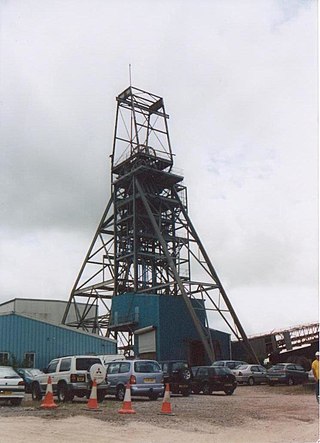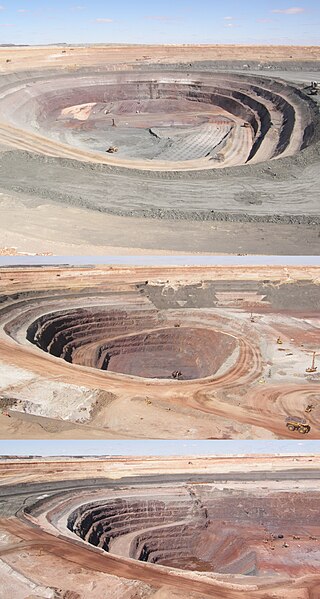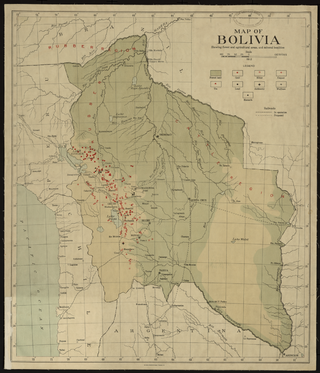
The tin mining industry on Dartmoor, Devon, England, is thought to have originated in pre-Roman times, and continued right through to the 20th century, when the last commercially worked mine closed in November 1930. From the 12th century onwards tin mining was regulated by a stannary parliament which had its own laws.

Mining in Cornwall and Devon, in the southwest of England, began in the early Bronze Age, around 2150 BC. Tin, and later copper, were the most commonly extracted metals. Some tin mining continued long after the mining of other metals had become unprofitable, but ended in the late 20th century. In 2021, it was announced that a new mine was extracting battery-grade lithium carbonate, more than 20 years after the closure of the last South Crofty tin mine in Cornwall in 1998.

The Challenger mine is a gold mine in the Far North of South Australia, 165 km west of the Stuart Highway and 740 km north-west of Adelaide. It was operated by Dominion, Kingsgate and then WPG Resources. The mine is now on Care and Maintenance. The deposit was named by the geologist who discovered it, after his dog.

South Crofty is a metalliferous tin and copper mine located in the village of Pool, Cornwall, United Kingdom. An ancient mine, it has seen production for over 400 years, and extends almost two and a half miles across and 3,000 feet (910 m) down and has mined over 40 lodes. Evidence of mining activity in South Crofty has been dated back to 1592, with full-scale mining beginning in the mid-17th century. The mine went into serious decline after 1985 and eventually closed in 1998. After several changes of ownership, South Crofty is owned by Cornish Metals Inc, which is working to re-open the mine, as of November 2022, having receive a permit for dewatering the mine.

Drakelands Mine, also known as Hemerdon Mine or Hemerdon Ball Mine, is a tungsten and tin mine. It is located 11 km northeast of Plymouth, near Plympton, in Devon, England. It lies to the north of the villages of Sparkwell and Hemerdon, and adjacent to the large china clay pits near Lee Moor. The mine had been out of operation since 1944, except for the brief operation of a trial mine in the 1980s. Work started to re-open it in 2014, but it ceased activities in 2018. It hosts the fourth largest tin-tungsten deposit in the world.

The Prominent Hill Mine is a major copper, silver, and gold mine in north west South Australia, 130 km south-east of Coober Pedy, which has been developed by Oxiana Limited, later to become OZ Minerals. The deposit is an iron oxide copper gold style mineralisation.

SAG/SDAG Wismut was a uranium mining company in East Germany during the time of the Cold War. It produced a total of 230,400 tonnes of uranium between 1947 and 1990 and made East Germany the fourth largest producer of uranium ore in the world at the time. It was the largest single producer of uranium ore in the entire sphere of control of the USSR. In 1991 after German reunification it was transformed into the Wismut GmbH company, owned by the Federal Republic of Germany, which is now responsible for the restoration and environmental cleanup of the former mining and milling areas. The head office of SDAG Wismut / Wismut GmbH is in Chemnitz-Siegmar.
Allkem Limited, known as Orocobre Limited until 30 November 2021, is a mineral resource company based in Brisbane, Australia. The company's present focus is on lithium and borax mining operations within Argentina. Since 2007 Orocobre Ltd. is registered at the Australian Securities Exchange ASX and as of 2010 listed on the TSX. The company is included in the S&P/ASX 300 Index.
Adex Mining Inc. is a Toronto, Ontario, Canada-based mining exploration company engaged in the development of its wholly owned Mount Pleasant Mine property in Charlotte County, New Brunswick, Canada. According to a Government of Canada report, Mount Pleasant is "North America's largest tin deposit and the world's largest reserve of indium." The company's stock trades on the TSX Venture Exchange under the symbol ADE.

Mining in the United Kingdom produces a wide variety of fossil fuels, metals, and industrial minerals due to its complex geology. In 2013, there were over 2,000 active mines, quarries, and offshore drilling sites on the continental land mass of the United Kingdom producing £34bn of minerals and employing 36,000 people.

Mining in Bolivia has been a dominant feature of the Bolivian economy as well as Bolivian politics since 1557. Colonial era silver mining in Bolivia, particularly in Potosí, played a critical role in the Spanish Empire and the global economy. Tin mining supplanted silver by the twentieth century and the central element of Bolivian mining, and wealthy tin barons played an important role in national politics until they were marginalized by the industry's nationalization into the Bolivian Mining Corporation that followed the 1952 revolution. Bolivian miners played a critical part to the country's organized labor movement from the 1940s to the 1980s.
The BrightStar Gold Mine is a gold project located 35 km south-east of Laverton, Western Australia. Operations at Brightstar are suspended with the processing plant under care and maintenance.
The Thunderbox Gold Mine is a gold mine 41 km south-east of Leinster, Western Australia. It was formerly owned by Norilsk Nickel, which placed it in care and maintenance in 2007, but is now owned by Northern Star Resources.
Cominco Resources is a private company which is developing the US$2billion Hinda phosphate project located in The Republic of the Congo. Through its subsidiary it owns 100% of the Hinda Phosphate Project, which comprises the Hinda Permit, and the Kolatchikanou Permit. The Hinda project is the world's largest undeveloped phosphate deposit with a JORC Mineral Resource of 678 Mt and a Minable Ore Reserve of 405 Mt, sufficient for over 24 years of production. Cominco Resources was merged with Kropz in December 2018 and listed on the AIM market.

Iron Road Ltd is an Australian iron ore exploration and mining company, listed on the Australian Securities Exchange in Perth, Western Australia since 2008 with an objective to develop a world class magnetite mine and infrastructure in South Australia. Its two projects were the Central Eyre Iron Project (CEIP), the planned output of which was to be 24 million tonnes per annum of approximately 67 per cent iron concentrate for almost 30 years; and the Gawler Iron Project, in abeyance as of 2021. The company's corporate office is in Adelaide.
Valence Industries was the company that owned the Uley Graphite Project and associated facilities near Port Lincoln in regional South Australia. The project is one of the largest coarse flake graphite deposits in the world, and is acknowledged as a significant area of graphite mineralisation. Valence Industries changed its name to Quantum Graphite Limited on 14 July 2017. The company's shares are suspended from trading and it is subject to a deed of company arrangement.

The mining industry of Uganda, documented as early as the 1920s, witnessed a boom in the 1950s with a record 30 percent of the country's exports. It received a further boost when mining revenues increased by 48 percent between 1995 and 1997. However, the World Bank reported that the sector's contribution to gross domestic product (GDP) dropped from 6 percent during the 1970s to below 0.5 percent in 2010. Uganda's extractive industry activities have been identified by the Natural Resource Governance Institute as focused on "extraction of cobalt, gold, copper, iron ore, tungsten, steel, tin and other industrial products such as cement, diamonds, salt and vermiculite". Limestone is sold in local markets whereas gold, tin, and tungsten are major exports.
Almonty Industries is a global mining company focused on tungsten mining and exploration. Its primary operations are in Spain, Portugal, and South Korea. The company is listed on the Toronto Stock Exchange.
Lithium mining in Australia is highlighted by the Greenbushes hard-rock lithium mine in Western Australia, labelled by the Sydney Morning Herald, "the world's largest hard-rock lithium mine". Lithium is a soft metal with a silvery-white appearance. It is recovered from mineral deposits, mostly from spodumene and large lithium rich brines in salt lakes. According to Statista, as of 2018, Australia has surpassed Chile to become the largest producer of lithium by metric tonnes. Australia is home to lithium miners, Orocobre, Core Lithium, Galaxy Resources, Pilbara Minerals, Mineral Resources and Altura Mining with most of the large lithium miners producing lithium from hard-rock spodumene in Western Australia.
The Finnis Lithium Project is a lithium mine being developed near Darwin, Northern Territory, Australia. The project is being developed by Core Lithium.













